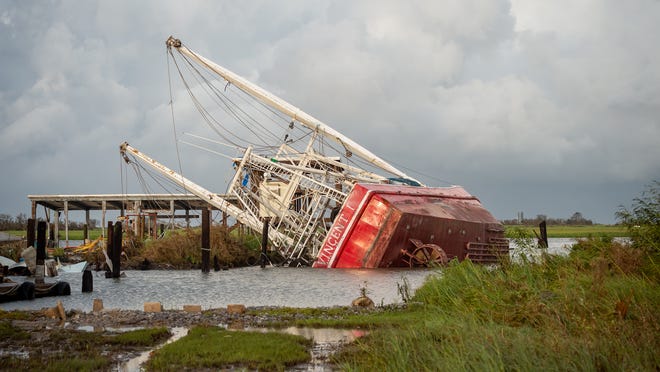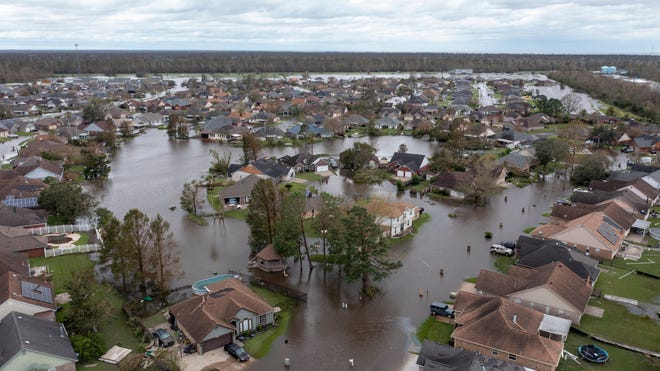
Editor's note: Having trouble connecting? Read USA TODAY's text-only storm updates.
The lack of electricity combined with steamy late-summer weather to make for miserable conditions for hundreds of thousands of Louisianans trying to recover from the impacts of Hurricane Ida, one of the most powerful storms ever to hit the U.S.
Lines that stretched for city blocks became a common sight Tuesday at the few gas stations that remained open as southeastern Louisiana residents sought fuel for their generators and vehicles.
More than 1 million homes and businesses in the state -- adding up to more than 2 million residents -- were out of power after Ida devastated the electric grid upon making landfall Sunday, leaving all of New Orleans in the dark. The storm's 150 mph winds toppled a major transmission tower and knocked out thousands of miles of lines and hundreds of substations.
New Orleans Mayor LaToya Cantrell, who announced a nighttime curfew Tuesday to prevent crime, said some power may be restored by Wednesday evening but not on a widespread basis.
“We know it’s hot. We know we do not have any power and that continues to be a priority,” she said in a news conference.
The utility Entergy New Orleans said assessing damage may take several days because of difficulty accessing some areas. The expectation is it will take weeks for customers in hard-hit locations to get electricity back.
Entergy said it was considering two options for bringing power back with an initial focus on "critical infrastructure in the area such as hospitals, nursing homes and first responders.”
With water treatment plants overwhelmed by floodwaters or crippled by power outages, some places were also facing shortages of drinking water. About 441,000 people in 17 parishes had no water, and an additional 319,000 were under boil-water advisories, federal officials said.
“We have a lot of work ahead of us and no one is under the illusion that this is going to be a short process,” Gov. John Bel Edwards said.
Local and state officials set up locations where residents could get water, ice and food as well as get a break from the stifling heat in air conditioning, including 70 transit buses New Orleans started using as cooling sites.
The death toll from Ida rose to at least four after a highway collapsed in Mississippi, and flooding remained a threat Tuesday as remnants of the monster storm swept across the Southeast.
"Some of these cars are stacked on top of each other," Mississippi Highway Patrol Cp. Cal Robertson said.
Two deaths have been confirmed in Louisiana, including a person hit by a falling tree outside Baton Rouge and a driver who drowned in New Orleans. Edwards said at least 671 people had been rescued from floodwaters in Louisiana by Monday afternoon.
Ida roared onto the Gulf Coast near Port Fourchon, Louisiana, on Sunday as a Category 4 hurricane, its 150-mph winds tying it for the fifth strongest such storm to make landfall in the U.S. mainland. Ida had quieted to tropical depression status Tuesday with sustained winds of 30 mph. The National Weather Service warned that the heavy rain and flooding threat it brought would spread from the Tennessee and Ohio valleys up through the Mid-Atlantic states on Wednesday.
"Considerable flash flooding is possible," meteorologist Alex Lamers said.
Hundreds rescued in Louisiana, where more than 1 million are out of power; 2 dead
Gov. Edwards warns residents who left to stay away: 'Now is really the most dangerous time'
The Louisiana governor and a top federal official delivered a clear, concise message Tuesday to those eager to return home after fleeing from powerful Hurricane Ida: Stay away for now.
Speaking at a news conference in hard-hit LaPlace, part of the New Orleans metropolitan area, Gov. John Bel Edwards said current conditions in parts of the region are not suitable for residents.
“Many of the life-supporting infrastructure elements are not present, they’re not operating right now,’’ Edwards said. “So if you have already evacuated, do not return here or elsewhere in southeast Louisiana until the Office of Emergency Preparedness tells you that it’s ready to receive you. The schools are not open, the businesses are not open, the hospitals are slammed. There’s not water in your home, and there’s not going to be electricity.’’
More than 1 million homes and businesses are still without power in Louisiana after it was walloped by Ida on Sunday, and Edwards warned that the heat index is expected to hit the 100-degree mark in the next two weeks, longer than it will take for some areas to get electricity back.
He also said that while there have been two confirmed deaths in the state so far, the number is certain to rise. He pointed out that historically in major storms the majority of fatalities occur during the response, be it from heat exhaustion, motorists driving through floodwaters, people using power equipment they’re not familiar with or getting poisoned by carbon monoxide from portable generators.
“Now is really the most dangerous time, over the next week, couple of weeks,’’ Edwards said, “so we’re asking people to be patient, we’re asking people to be careful.’’
Deanne Criswell, administrator of the Federal Emergency Management Agency, acknowledged communication systems were impaired by the storm, and said FEMA personnel will be available to register affected residents for federal assistance. She named several other federal agencies already on the ground lending support, and exhorted residents to check in on their neighbors and loved ones.
“People are going to need help, and what I have found across the country is just how amazing it is that the communities come together and help each other out,’’ Criswell said. “It really goes a long way.’’
40 who rode out storm in Grand Isle doing all right
Jefferson Parish President Cynthia Lee Sheng said all 40 people who rode out Hurricane Ida in the fishing community of Grand Isle were accounted for and doing OK. As the storm intensified and began pummeling homes, many of them ran to an area fire department for shelter, she said. They are still cut off from the mainland because the sole highway is flooded and impassable.
The floodwaters engulfing Lafitte, 28 miles south of New Orleans, stretched out for more than a mile past the city limits, she said. More than 100 people had been rescued from Lafitte and other embattled communities, Sheng said. Around 30 people are also in shelters.
As hard as her parish was hit by Ida, things could have been much worse without the $14.5 billion hurricane protection system erected after Hurricane Katrina in 2005, she said.
“This would have been catastrophic,” Sheng said. “We would all be underwater.”
-- Rick Jervis
New Orleans airport cancels flights for third day
Louis Armstrong New Orleans International Airport canceled all incoming and outgoing commercial flights for a third day Tuesday, and at least 197 cancellations were already reported for Wednesday. The airport said the lack of power and water meant no air conditioning or restrooms. Parking operators have not observed any significant damage to vehicles, the airport said in a tweet.
The terminal, runways and taxiways appeared to have sustained no serious damage, officials said. Debris was being cleared and some perimeter fencing was being repaired.
New Orleans police deploy anti-looting teams
The New Orleans Police Department said it has deployed anti-looting teams across the city to protect property during the recovery process. Videos circulated on social media appear to show some businesses being cleaned out by looters. Mayor LaToya Cantrell emphasized at a press conference on Monday that “there is no widespread looting operation going on throughout the city of New Orleans,” and vowed to lock up anyone caught in the act.
"Looting will NOT be tolerated and (we) encourage everyone to be good neighbors and say something when you see something," the department tweeted.
Waverly, Tennessee, could face more flooding 10 days after tragedy
The remnants of Hurricane Ida are headed to Tennessee and are expected to bring up to five inches of rain to the town of Waverly, where 20 people died in flooding just 10 days ago. The forecast includes a flash flood watch. Waverly is expected to receive 24 hours of almost continuous moderate to heavy rain through Tuesday night.
"The system overall is weakening, but it is going to bring a lot of rain up here," said John Cohen, a National Weather Service meteorologist in Nashville.
Last week's high temperatures and sun helped dry out lawns and the growing piles of debris. But a blast from Ida could hinder the town's effort to trudge forward. Gretchen Turner's kitchen cabinets, leather couch, suitcases and many of her other belongings were piled onto her front lawn.
"It's sort of demoralizing when you're working so hard and then everything gets wet," Turner said. "We still have lots of dirt everywhere, but it's about to be mud again."
Two die in Mississippi highway collapse
Two people were killed and at least 10 others were injured when their vehicles plunged into a deep hole where a highway collapsed after Ida blew through George County, Mississippi. Torrential rain may have caused the collapse, and the drivers may not have seen that the roadway in front of them had disappeared Monday night, Mississippi Highway Patrol Cp. Cal Robertson said. Seven vehicles were involved, including a motorcycle. A crane was brought in to lift them out of the hole, which Robertson said was 50 to 60 feet in length and 20 to 30 feet deep.
How to help:Want to donate or volunteer to assist those affected by Hurricane Ida? Here's how to help
Ida creating a 'pandemic tinderbox' for parts of Louisiana
Experts worry Ida's impact, straining hospital and health resources, will worsen COVID-19 spread in the state's low-lying parishes, where some vaccination rates are only about a third of the population and cases have surged to all-time highs. Crowded shelters, delayed treatments and inundated hospitals and intensive care units are a recipe that put under-vaccinated communities at dire risk for more infections, experts said. The unvaccinated account for the majority of deaths and hospitalizations.
“This is a pandemic tinderbox,” said pediatrician Irwin Redlener, founding director of Columbia University’s National Center for Disaster Preparedness.
– Nada Hassanein
Alligator rips off man's arm in floodwaters
A man was attacked by an alligator in floodwaters near the city of Slidell, just across Lake Pontchartrain from New Orleans, Jason Gaubert, a spokesman for the St. Tammany Fire District No. 1, told USA TODAY. Gaubert said the attack took the man's arm off and his wife went to call for help. When she returned, he had disappeared in the floodwaters. The man's body hasn't been recovered and officials were investigating. Jefferson Parish President Cynthia Lee Sheng noted some swamplands had flooded and dangers were real for first responders and those living in the area.
"This is an area that has a lot of swampland, alligators, very dangerous conditions," she told CNN, adding that some areas saw flooding that was "beyond chest high. It's up to the top of the roof."
– Christal Hayes
The Associated Press contributed to this report.








